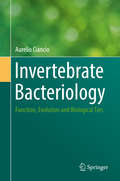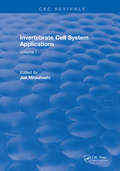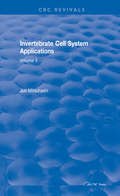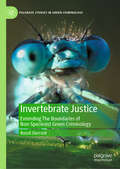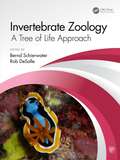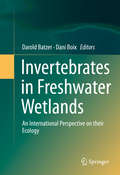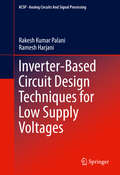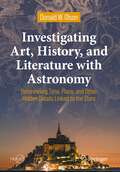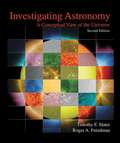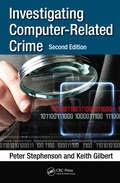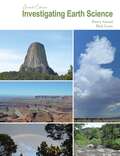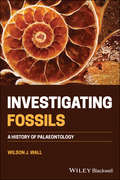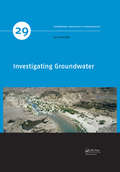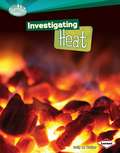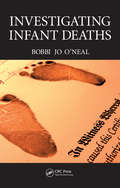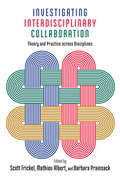- Table View
- List View
Invertebrate Bacteriology
by Aurelio CiancioThis compendium reviews different processes acting on bacterial groups that evolved one or more relationships with members of the most important invertebrate Phyla. Starting from principles of basic bacteriology the book provides data on bacteria interactions with pests, animal or human diseases. Being present in all environments, from deep see to crops, animals or plants, invertebrates represent the most significant and ancient fraction of the eukaryotic biomass on earth. Their evolutive adaptations and links with bacteria, established over time scales of ages, range from vectored diseases to speciation, within a wide range of environmental niches and biocenosis, including oceanic hydrothermal vents. Main functional processes include pathogenicity, parasitism, transmission, immunity, symbiosis and speciation. A review about recent advances achieved in these research topics is given, focussing on one or more aspects concerning significant evolutive paths of bacteria and underlying functional links. Rather than proceeding through the order and structure of taxonomies, the volume is organized by processes, examining their functional role in different lineages, including but not limited to insects or nematodes. Processes involved in parasitism focus, at a finer level, on examples from many taxa. Molecular aspects underpinning these and other functional processes include the effects of horizontal gene transfer, the mechanisms active in immune defense and vectoring, and the antibacterial peptides. Finally, the effects of climate warming, biological invasions and agriculture are examined, with particular attention to farming and environment.
Invertebrate Cell System Applications: Volume I
by Jun MitsuhashiA useful reference for those using or interested in cultured invertebrate cells, this two-volume text provides information about techniques and advances in invertebrate tissue culture. Cell lines for Insecta, Crustacea, Mollusca, and Nematoda are introduces along with their characterizations. Developments in insect biotechnology, including foreign protein production by insect cells infected with recombinant virus are described. Fundamental studies for introducing foreign genes into cultured insect cells is also presented. Wide information on studies -at cellular levels-on pathogens of insects, plants, and vertebrates is given.
Invertebrate Cell System Applications: Volume II
by Jun MitsuhashiA useful reference for those using or interested in cultured invertebrate cells, this two-volume text provides information about techniques and advances in invertebrate tissue culture. Cell lines for Insecta, Crustacea, Mollusca, and Nematoda are introduces along with their characterizations. Developments in insect biotechnology, including foreign protein production by insect cells infected with recombinant virus are described. Fundamental studies for introducing foreign genes into cultured insect cells is also presented. Wide information on studies -at cellular levels-on pathogens of insects, plants, and vertebrates is given.
Invertebrate Justice: Extending The Boundaries of Non-Speciesist Green Criminology (Palgrave Studies in Green Criminology)
by Russil DurrantInvertebrates are the neglected majority of the animal world. Even though they make up over 95% of animal life, they rarely feature in discussions of speciesism, animal ethics or species justice. This book aims to extend the work of non-speciesist criminologists to argue for the idea of ‘invertebrate justice’. Utilizing green criminologist Rob White’s (2013) eco-justice perspective, the book demonstrates how our interactions with invertebrate species (insects, crustaceans, molluscs and so forth) cause a significant amount of harm to those animals themselves (species justice), the ecosystems in which they are embedded (ecological justice), and ultimately to humans (environmental justice). Across three sections, it provides an overview of the ways in which humans and invertebrates interact across a diverse range of contexts and reviews the literature on both invertebrate biodiversity and invertebrate sentience; builds a theoretical framework that can help us understand what invertebrate justice might mean; and tackles the difficult question of how best we can promote invertebrate justice in the future. It appeals to academics, environmental scientists, activists and policymakers.
Invertebrate Zoology: A Tree of Life Approach
by Rob DeSalle Bernd SchierwaterInvertebrate Zoology: A Tree of Life Approach is a comprehensive and authoritative textbook adopting an explicitly phylogenetic organization. Most of the classical anatomical and morphological work has not been changed – it established the foundation of Invertebrate Zoology. With the explosion of Next-Generation Sequencing approaches, there has been a sea-change in the recognized phylogenetic relationships among and between invertebrate lineages. In addition, the merger of evolutionary and developmental biology (evo-devo) has dramatically contributed to changes in the understanding of invertebrate biology. Synthesizing these three approaches (classical morphology, sequencing data, and evo-devo studies) offers students an entirely unique perspective of invertebrate diversity. Key Features One of the first textbooks to combine classical morphological approaches and newer evo-devo and Next-Generation Sequencing approaches to address Invertebrate Zoology Organized along taxonomic lines in accord with the latest understanding of invertebrate phylogeny Will provide background in basic systematic analysis useful within any study of biodiversity A wealth of ancillary materials for students and teachers, including downloadable figures, lecture slides, web links, and phylogenetic data matrices
Invertebrates in Freshwater Wetlands
by Darold Batzer Dani BoixWetlands are among the world's most valuable and most threatened habitats, and in these crucially important ecosystems, the invertebrate fauna holds a focal position. Most of the biological diversity in wetlands is found within resident invertebrate assemblages, and those invertebrates are the primary trophic link between lower plants and higher vertebrates (e. g. amphibians, fish, and birds). As such, most scientists, managers, consultants, and students who work in the world's wetlands should become better informed about the invertebrate components in their habitats of interest. Our book serves to fill this need by assembling the world's most prominent ecologists working on freshwater wetland invertebrates, and having them provide authoritative perspectives on each the world's most important freshwater wetland types. The initial chapter of the book provides a primer on freshwater wetland invertebrates, including how they are uniquely adapted for life in wetland environments and how they contribute to important ecological functions in wetland ecosystems. The next 15 chapters deal with invertebrates in the major wetlands across the globe (rock pools, alpine ponds, temperate temporary ponds, Mediterranean temporary ponds, turloughs, peatlands, permanent marshes, Great Lakes marshes, Everglades, springs, beaver ponds, temperate floodplains, neotropical floodplains, created wetlands, waterfowl marshes), each chapter written by groups of prominent scientists intimately knowledgeable about the individualwetland types. Each chapter reviews the relevant literature, provides asynthesis of the most important ecological controls on the residentinvertebrate fauna, and highlights important conservation concerns. The finalchapter synthesizes the 15 habitat-based chapters, providing a macroscopicperspective on natural variation of invertebrate assemblage structure acrossthe world's wetlands and a paradigm for understanding how global variation andenvironmental factors shape wetland invertebrate communities.
Inverter-Based Circuit Design Techniques for Low Supply Voltages
by Ramesh Harjani Rakesh Kumar PalaniThis book describes intuitive analog design approaches using digital inverters, providing filter architectures and circuit techniques enabling high performance analog circuit design. The authors provide process, supply voltage and temperature (PVT) variation-tolerant design techniques for inverter based circuits. They also discuss various analog design techniques for lower technology nodes and lower power supply, which can be used for designing high performance systems-on-chip.
Investigate Matter (Inspire Science, Grade 5 #Unit 1)
by McGraw-Hill EducationNIMAC-sourced textbook
Investigating Art, History, and Literature with Astronomy: Determining Time, Place, and Other Hidden Details Linked to the Stars (Springer Praxis Books)
by Donald W. OlsonHow can shadows determine the date and time of a painting by Johannes Vermeer? How did the Moon and tides cause the loss of King John’s crown jewels? In his newest book, Professor Olson, author of Celestial Sleuth and Further Adventures of the Celestial Sleuth, explores how astronomical clues can uncover fascinating new details about art, history, and literature. He begins with an accessible introduction to amateur “celestial sleuthing,” showing how to use your astronomical knowledge, software, archives, vintage maps, historical letters and diaries, military records, and other resources to investigate the past. Follow along as Professor Olson then explores twenty real-world cases where astronomy has helped answer unresolved questions or correct longstanding interpretations about an event. Examples involve artists such as Vermeer, Monet, and O’Keeffe; the historical exploits of Alexander the Great, the desert travels of the Death Valley ’49ers, and a meeting between Franklin D. Roosevelt and Winston Churchill in Marrakech; and literary works by Chaucer, Shakespeare, and Longfellow. Packed with dozens of full-color illustrations, this book will enrich your knowledge of the past and equip you with all the tools you’ll need to become a celestial sleuth yourself. “Many people have a passion for art, or world history, or great literature, or even astronomy — but seldom in all these things at once. This remarkable book by Donald Olson of Texas State University will put you in touch with such seemingly unrelated endeavors. It will open your eyes and broaden your mind as little else could.” Roger W. Sinnott, Sky & Telescope
Investigating Astronomy
by Jodi E. Asbell-Clarke Erin M. Bardar Teon E. Edwards Jefffrey F. LockwoodInvestigating Astronomy is the first comprehensive astronomy textbook written specifically for high school students. In writing this book, we have tried to include all the major topics in an astronomy course while also engaging you in hands-on investigations and using tools that will help you learn in an interactive and meaningful way. The book also focuses on scientific inquiry, the process of making scientific claims and supporting them with evidence, and using scientific reasoning to justify and revise those claims.
Investigating Astronomy: A Conceptual View of the Universe (Second Edition)
by Roger Freedman Timothy F. SlaterWith a careful selection of topics, a focus on conceptual understanding, and a strong theme of scientific process, Investigating Astronomy offers a compelling presentation for students learning introductory astronomy. The updated new edition includes cutting-edge research in the field and provides a contemporary view of the nature of science.
Investigating Being in Organizations and Leadership: A Phenomenological Alternative
by Michael Fast Kim Malmbak MøllerThis book discusses the ontological foundation for organizational analysis and organizational life from a phenomenological perspective. The objective of this book is to provide the reader with an understanding of organizations that adequately takes into account the current philosophical knowledge regarding human nature. A key result of this analysis is that organizations are existentially founded human experiences of emotions, ethics, culture and narrative. This understanding of organizations is furthermore complicated by the existence of concepts of power, relationship, interaction and identity, which all can be perceived as contradicting notions of objectivity, professionalism and rationalism. The question is not whether this is an easy description to navigate nor apply, but rather where we go from here. This book would be of interest to students and scholars working on the philosophy of business, and academics in critical organization studies and alternative philosophy of organization. The book would also be of interest to people in all organization trying to understand everyday of dilemmas and contradictions.
Investigating Biodiversity and Interdependence, Student Guide
by National Science Resources Center Amy Charles Max-Karl WinklerNIMAC-sourced textbook
Investigating Computer-Related Crime
by Peter Stephenson Keith GilbertSince the last edition of this book was written more than a decade ago, cybercrime has evolved. Motives have not changed, but new means and opportunities have arisen with the advancement of the digital age. Investigating Computer-Related Crime: Second Edition incorporates the results of research and practice in a variety of venues, growth in the fi
Investigating Digestion and Motion, Student Guide
by National Science Resources Center Wordwise Inc. Taina LitwakNIMAC-sourced textbook
Investigating Earth Science
by Dusty Girard Rick LynnInvestigating Earth Science is a lab manual designed to meet the requirements of an introductory geology course for non-science majors. <p><p> In order to meet the needs of a broad based geology course many topics are covered including the scientific method, mineral and rock formation and identification, water issues, coordinate systems and mapping, geologic time, the atmosphere, weather and climate, and astronomy. <p><p> This lab manual is designed to complement the lecture component of an introductory geology lecture course to reinforce and enhance student’s understanding of Earth processes, human interaction with our environment and the place of the Earth and humans in our solar system and universe. The major goal of this lab manual is to help students understand the importance of how science works, how scientists think and how science impacts the student’s life on a daily basis.
Investigating Earth Systems: Investigating Our Dynamic Planet
by Michael J. Smith John B. Southard Colin MablyAn Inquiry program that goes into detail about investigating our planet Earth.
Investigating Fossils: A History of Palaeontology
by Wilson J. WallINVESTIGATING FOSSILS INVESTIGATING FOSSILSA HISTORY OF PALAEONTOLOGYInvestigating Fossils – A History of Palaeontology is a concise and accessible look at changing attitudes to palaeontology in general, and fossils in particular. From the existential and philosophical debates arising from fossils – such as their implications for the age of the Earth – to their role as markers in Darwin’s theory of evolution, fossils have been the centre of highly charged debate for over two centuries.This book, which is aimed at anyone with an interest in the history and philosophy of science, not only describes the process of fossil formation and the history of the discovery of fossils. It goes further, and highlights the continuing importance of fossils to our ever-developing understanding of where the planet and its myriad species have come from.Painting a vivid, lively portrait of the history and development of palaeontology, Investigating Fossils is a fascinating and informative tour of the recent history – and possible future – of the science of fossils.
Investigating God's World (4th Edition)
by Matilda Nordtvedt Gregory Rickard Julie Rickard Stephen McalisterThe book investigates the things that you see every day and to know the laws that these objects of nature obey and how they all fit together in God's creation.
Investigating Groundwater (IAH - International Contributions to Hydrogeology #29)
by Ian AcworthInvestigating Groundwater provides an integrated approach to the challenges associated with locating groundwater. Uniquely, the book provides a review of the wide range of techniques that can be deployed to investigate this important resource. Many of the practical examples given are based upon Australian experience but the methods have worldwide applicability. The book is published in colour and includes many original diagrams and photographs. Particular effort has been made to provide consistent terminology and SI units are used throughout the text. <P><P>Investigating Groundwater starts with an introduction to the historical significance of groundwater and gives an account of climate change. A description of the occurrence of groundwater in different rock types is then provided. A detailed account of surface water techniques is then followed by an account of the interconnections between surface water and groundwater. Four chapters describing groundwater hydraulics are then followed by four chapters describing the latest geophysical techniques. Once the best location of a borehole is determined using these techniques; chapters then describe appropriate drilling methods to use; provide a wide ranging review of geophysical logging, hydrochemical and isotopic techniques, before concluding with a detailed description of groundwater flow to a well. <P><P>Written for a worldwide audience of degree level geology/engineering practitioners, academics and students involved in groundwater resource investigation methods; Investigating Groundwater is essential reading for those involved in groundwater research. <P><P>Key Features: <li>Presents the theoretical background and a detailed description of the techniques used in the investigation of groundwater. <li>Describes the general occurrence of groundwater in different rock types; surface water hydrology and interconnected surface and groundwater systems. <li>Provides detailed descriptions of geophysical techniques (seismic, electrical, gravity and heat) and an account of available geophysical logging methods. <li>Reviews hydrochemical and isotope methods, followed by an account of drilling techniques. <li>Gives a detailed account of radial flow to a well, including appropriate modelling and pump-testing techniques and a consideration of non-linear flow. <P><P>Of interest to anyone involved in the development of groundwater resources, either for domestic supply, for agriculture or for mining.
Investigating Heat (Searchlight Books - How Does Energy Work?)
by Sally M. WalkerThe sun, furnaces, and ovens all make heat. But have you ever watched matter expand when it is heated? Or seen how different kinds of matter conduct heat? Now you can! Explore heat with the fun experiments you'll find in this book. As part of the Searchlight Books™ collection, this series sheds light on a key science question―How Does Energy Work? Hands-on experiments, interesting photos, and useful diagrams will help you find the answer!
Investigating Infant Deaths
by Bobbi Jo O'NealMany forensic pathologists and death investigators would agree that infant deaths have historically been poorly investigated. Investigating Infant Deaths provides an in-depth guide featuring 40 case examples that illustrates real-life scenarios in which techniques are put into action. It explains techniques for interviewing grieving parents, how to perform an initial post-mortem exam, what to look for at the incident scene, and the goals of state and local child fatality teams. It also presents suggestions for using doll re-enactments to interview surviving caregivers and witnesses as well as 44 pictures of scenes and unsafe environments.
Investigating Interdisciplinary Collaboration: Theory and Practice across Disciplines
by Helga Nowotny Barbara Prainsack Gregory J. Downey Aaron Panofsky Daniel Lee Kleinman Angela Cassidy Ali O. Ilhan Ayelet Kuper Chisato Fukuda Cyrus C.M. Mody Dave Mcbee Elise Paradis Erin Leahey Hauke Reisch Itai Vardi Jennifer Croissant Laurel Smith-Doerr Mathieu Albert Noah Weeth Feinstein Ryan Light Scott Frickel Sigrid Peterson Timothy Sacco Jimi AdamsInterdisciplinarity has become a buzzword in academia, as research universities funnel their financial resources toward collaborations between faculty in different disciplines. In theory, interdisciplinary collaboration breaks down artificial divisions between different departments, allowing more innovative and sophisticated research to flourish. But does it actually work this way in practice? Investigating Interdisciplinary Collaboration puts the common beliefs about such research to the test, using empirical data gathered by scholars from the United States, Canada, and Great Britain. The book’s contributors critically interrogate the assumptions underlying the fervor for interdisciplinarity. Their attentive scholarship reveals how, for all its potential benefits, interdisciplinary collaboration is neither immune to academia’s status hierarchies, nor a simple antidote to the alleged shortcomings of disciplinary study.
Investigating Life Systems 3rd Edition
by Kendall Hunt Pubishing Company[This book] introduces key ideas from the life sciences. In Unit 1, students examine systems that are in and out of balance and develop a conceptual understanding of systems. In Unit 2, they look at characteristics and causes of variations in populations. They study genetics and patterns of inheritance, as well as the ethical issues associated with genetic engineering. In Unit 3, they look at change in systems by studying the theory of evolution as an example of an idea that has changed over time, as well as a scientific explanation for changes in living organisms. By studying population systems in Unit 4, the students pull together all of these concepts related to living systems and focus on population growth in general, and the human population system specifically, to learn about the interrelationships that influence systemwide changes.
